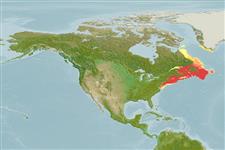Environment: milieu / climate zone / depth range / distribution range
Écologie
marin; saumâtre démersal; océanodrome (Ref. 51243); profondeur 0 - 388 m (Ref. 58426). Temperate; ? - 10°C (Ref. 35432); 63°N - 37°N, 80°W - 43°W
Northwest Atlantic: Labrador, Canada to Delaware, USA.
Length at first maturity / Taille / Poids / Âge
Maturity: Lm 28.8 range ? - ? cm
Max length : 110 cm TL mâle / non sexé; (Ref. 7251); poids max. publié: 5.4 kg (Ref. 4926); âge max. reporté: 18 années (Ref. 796)
Benthic; feeds on worms, crustaceans, molluscs, sea squirts, sea urchins and fishes (Ref. 58426).
Life cycle and mating behavior
Maturité | Reproduction | Frai | Œufs | Fécondité | Larves
Eggs are laid in gelatinous masses guarded by one or both parents until hatching (Ref. 35432). However, more recent evidence suggests that care is provided by the female alone (Ref. 104883).
Anderson, M.E., 1994. Systematics and osteology of the Zoarcidae (Teleostei: Perciformes). Ichthyol. Bull. J.L.B. Smith Inst. Ichthyol. 60:120 p. (Ref. 11954)
Statut dans la liste rouge de l'IUCN (Ref. 130435: Version 2024-1)
Menace pour l'homme
Harmless
Utilisations par l'homme
Pêcheries: commercial; Aquarium: Commercial
Outils
Articles particuliers
Télécharger en XML
Sources Internet
Estimates based on models
Preferred temperature (Ref.
123201): 0.4 - 9.5, mean 3 °C (based on 227 cells).
Phylogenetic diversity index (Ref.
82804): PD
50 = 0.5156 [Uniqueness, from 0.5 = low to 2.0 = high].
Bayesian length-weight: a=0.00186 (0.00121 - 0.00287), b=3.20 (3.07 - 3.33), in cm total length, based on LWR estimates for this species & (Sub)family-body (Ref.
93245).
Niveau trophique (Ref.
69278): 4.2 ±0.1 se; based on diet studies.
Generation time: 14.5 ( na - na) years. Estimated as median ln(3)/K based on 2
growth studies.
Résilience (Ref.
120179): Faible, temps minimum de doublement de population : 4,5 à 14 années (K=0.08-0.11; tmax=18).
Prior r = 0.09, 95% CL = 0.06 - 0.14, Based on 2 full stock assessments.
Fishing Vulnerability (Ref.
59153): High to very high vulnerability (67 of 100).
Climate Vulnerability (Ref.
125649): High to very high vulnerability (74 of 100).
Nutrients (Ref.
124155): Calcium = 21 [13, 34] mg/100g; Iron = 0.251 [0.157, 0.407] mg/100g; Protein = 18 [15, 20] %; Omega3 = 0.436 [0.268, 0.701] g/100g; Selenium = 21.5 [11.0, 41.1] μg/100g; VitaminA = 9.16 [3.35, 25.13] μg/100g; Zinc = 0.458 [0.342, 0.634] mg/100g (wet weight);
